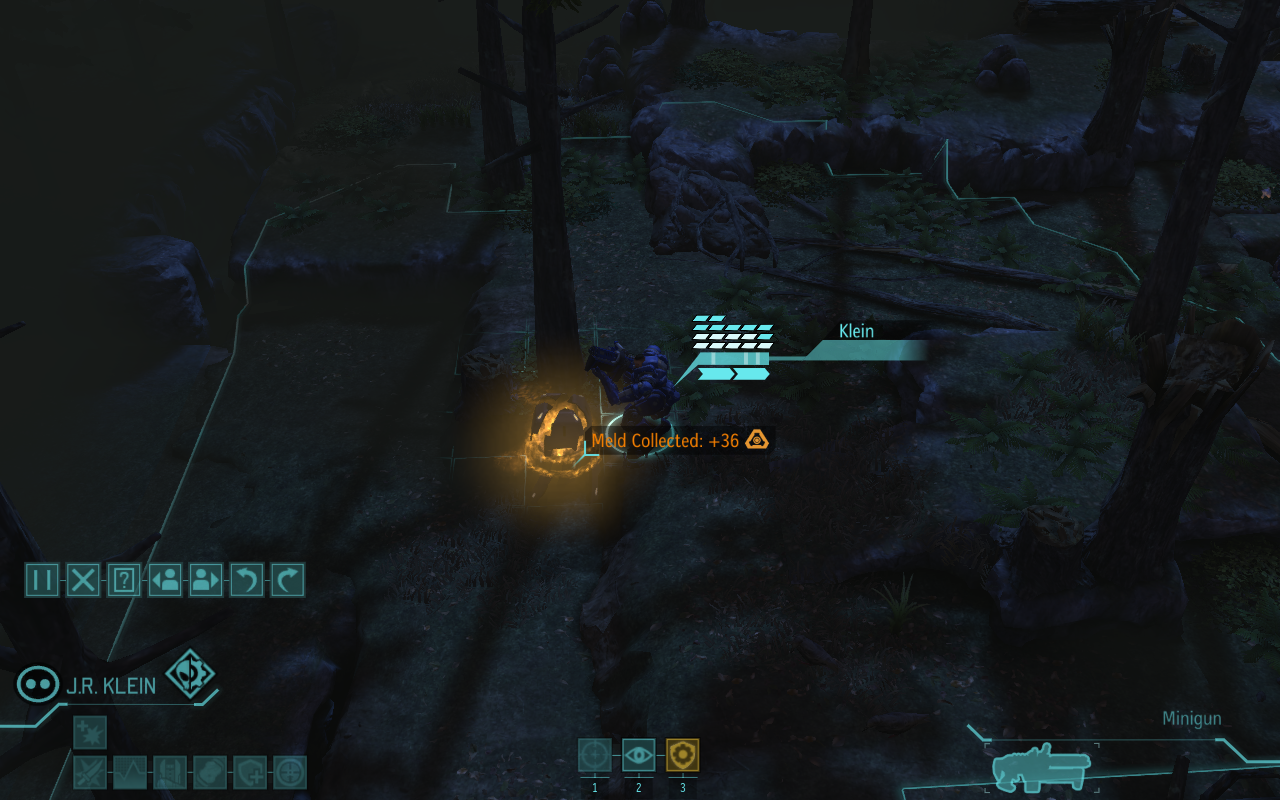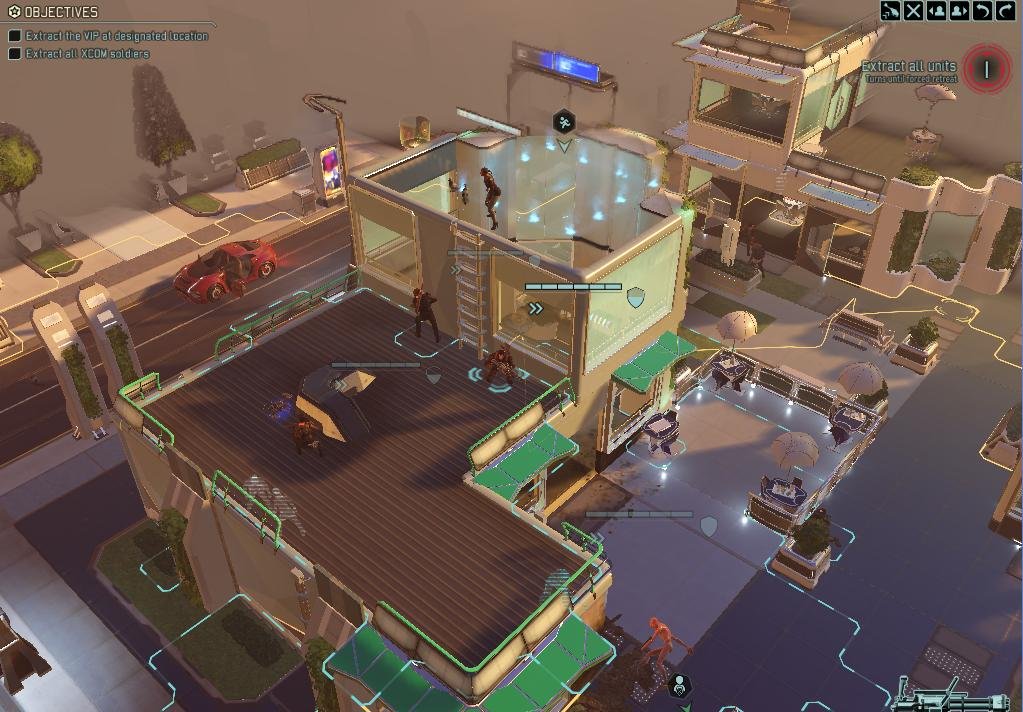Carrot or Stick? Fixing an XCOM Design Problem
The XCOM series reboot started with XCOM: Enemy Unknown, released in 2012. The game had a tightly-designed combat system with a big problem: all designed incentives led the player towards maximally conservative play. Instead of engaging deeply with the combat system, players found it more prudent to slowly and methodically creep forward through missions to expose themselves to as little risk as possible. Playing in this way is far less interesting than what the system could possibly support. Conservative play leads to few dangerous and complex situations–conservative play avoids the most interesting situations the game has to offer!
The developers recognized this issue and tried two different approaches to fixing the problem in follow-up releases.
The first attempt was in an expansion for XCOM 2012, Enemy WIthin. Enemy Within added “meld canisters” to maps which would expire after a certain number of turns. This design tries to encourage the player to move more aggressively and dive into riskier, more interesting combat encounters by placing timed rewards in the scary unknown. Once the player had collected a few of cannisters, they could use the meld to buy powerful augmentations for their soldiers.
In XCOM2, the developers ditched meld and instead added failure timers to most mission types. After the timer expired, the player would suffer a major punishment–usually any soldiers still on the map when the timer expired would be instantly captured or killed by the enemy. By putting a big punishment on a timer, this design forces the player to move at an uncomfortably high speed and accept risks in order to forestall a large punishment.
Carrots are Not Enough
On its face, Enemy Within’s meld canisters should encourage players to engage more deeply with combat. It’s a reward for playing faster and more aggressively–the first such incentive the developers added to the design. In isolation adding such a reward seems good, but the results of this design intervention were mixed because of XCOM’s character progression system and the relative scale of rewards and punishments.
 Losing a powerful character is a terrible blow to the player. Making a character incrementally more powerful is a boon, but on a comparatively much smaller scale. The player will see their many characters achieve increments of progress 20+ times during a campaign. Aside from characters gaining promotions and unlocking new skills, the player advances through a tech tree replete with helpful items they can equip to their characters to make them more effective in combat. A meld canister doesn’t even represent one such increment, it only represents abstract progress towards an improvement for one character. The player may suffer the injury or death of her soldiers for overextending when trying to reach a meld canister, but the quality of the reward for success is often minimal or non-existent. The reward is disproportionate to the potential costs.
Losing a powerful character is a terrible blow to the player. Making a character incrementally more powerful is a boon, but on a comparatively much smaller scale. The player will see their many characters achieve increments of progress 20+ times during a campaign. Aside from characters gaining promotions and unlocking new skills, the player advances through a tech tree replete with helpful items they can equip to their characters to make them more effective in combat. A meld canister doesn’t even represent one such increment, it only represents abstract progress towards an improvement for one character. The player may suffer the injury or death of her soldiers for overextending when trying to reach a meld canister, but the quality of the reward for success is often minimal or non-existent. The reward is disproportionate to the potential costs.
The reward also fits uneasily with campaign progression. Skilled players will reach meld canisters more often, which improves their characters faster, which makes it easier to reach meld canisters in future missions. This positive feedback loop further destabilizes the difficulty curve of a game that already suffers from frustrating negative snowball effects and boredom-inducing positive snowball effects. If the designers change the difficulty curve of the game to suit a player who can get most of the meld canisters, less-skilled players will be underpowered and frustrated by challenges as they get deeper into the game. If the designers leave the difficulty curve unchanged, players who get meld reliably will stomp through most of the game with the power meld buys. Perhaps a dynamic difficulty curve could solve this problem, but the scope of this design change is likely beyond the money and time limitations of the dev team, aside from being complex and difficult to design well under ideal conditions.
A positive incentive to take risks in combat doesn’t work well with the rest of the XCOM series’ design fixtures. The game penalizes poor play with sharp and large losses to the player’s effectiveness. Incremental rewards can’t balance such potential penalties. Any such rewards put more stress on an already unstable campaign difficulty design while doing nothing substantial to preventing players from playing in a boring but safe way.
As a player gets better, they can move more quickly across the map because they’re more confident in their ability to deal with difficult encounters. The game threatens a less-skilled player with terrible penalties for overextending their squad, and overextension is easier to do by mistake for a less-skilled player because they are less capable of dealing with complex combat encounters and limiting risk while under fire. The better player can play faster because he can better deal with the consequences of playing faster. The worse player stands to lose a lot from playing faster. For a positive incentive to draw a player out of super-conservative play, the reward has to be at least proportional to the penalties of failing due to the risks of pursuing the reward. In XCOM, the penalties are steeper for less-skilled players, but the meld reward is the same as it would be for an expert player. Meld as an incentive away from super-conservative play doesn’t work.
XCOM 2’s Attempted Fix
XCOM 2 tries to fix the crawling-forward incentive structure through two additional mechanisms:
- Before enemies spot the player’s squad, enemies see less far than player characters. The game calls this special condition “concealment.”
- Most missions are on timers with harsh penalties for exceeding the timer.
The concealment rules allow the player to lay a free ambush at the beginning of the first combat encounter in each mission. Since the player can see enemies while pods are inactive, she can maneuver her units into good positions from which to fight and activate the pod when it is best for her. This initial advantage makes this first combat encounter easier and thus makes it easier to survive (or get through unscathed) if additional pods are activated in the course of the first combat encounter.
The player can gain much useful information from exploiting the fact that her characters can see significantly further than enemies while in concealment. With this information, not only can the player plan the opening firefight in some detail, she can also scope out the composition and likely location of other pods in relation to the mission objectives. She knows a lot more about the likely course of the mission in XCOM2 because of this additional information than she could ever get in an XCOM2012 mission. From this, the player gains significant agency in how they pursue mission objectives and face combat challenges–such agency is sorely lacking in XCOM 2012.

Balancing this boon, the designers added timers to most mission types. These timers alone are enough to force players out of their defensive approach for some portion of the mission. Failing to complete the mission before the timer expires results in the player losing characters who haven’t reached the extraction zone (a small area of the map, usually on the other side of the map from the starting place). This punishment is similar in scale to the how the game can punish the player for putting their squad in danger. Because the player faces the loss of their characters if they’re too passive as well as too aggressive, they’re pushed towards middle ground–risking enough to get the mission done within the time limit, but not risking so much to suffer avoidable losses during that push.
Since the player starts in concealment and can see pods before she activates them, creeping forward slowly is less appealing. Concealment allows the player to scout enemy positions at little risk when the mission is at its most threatening, so the core reason for creeping forward withers into a minor concern instead of an overriding fear. XCOM2012’s disincentive for seeing enemies no longer applies. After the player has completed the initial ambush, she is in a similar situation to XCOM2012 but she can only creep forward for a few turns or she risks losing characters due to the timer expiring. The player can use information gleaned while in concealment about the likely location and composition of enemy pods to make aggressive moves that would be unjustifiably hazardous in XCOM2012.
The timer is complemented by mission objective design. The last mission objective in most XCOM2 missions is for the player to move her squad to a specific small area on the map. The player doesn’t have to kill all the enemies on the map. The enemies can behave aggressively to prevent the player from getting to her positional objective, and the player has the choose to engage or bypass whatever resistance stands in her way. This dynamic is far more complex than the typical systematically-hunt-and-destroy-at-minimal-risk dynamic of an XCOM2012 mission.
XCOM2’s timers fix the creeping forward problem by disincentivizing super-conservative play as much or more than the game disincentivizes overextension. The timer would create too harsh and arbitrary a punishment if added with no further modifications to the formula of XCOM2012, so the designers also added concealment. Concealment allows the player a temporarily safer environment in which to scout and an advantage in the first combat encounter of the mission. With more information at their disposal, the player can make plans to cope with the potential sharp penalty the timer may impose in the not-so-distant future.
XCOM2 does a much better job at putting the player into tough but survivable combat situations. Since this is the core of its tactical combat, I view it as a design success and an improvement over XCOM2012.
